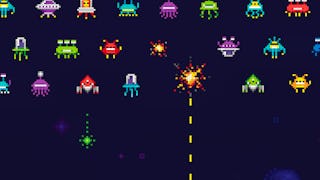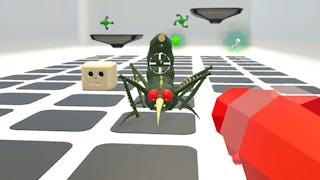If you love games and want to learn how to make them, then this course is your second step down that path. In this course you will learn the fundamentals of game design, including an understanding of the game world, storytelling, gameplay, user experience, and game technology. You will continue developing videogames using industry standard game development tools, including the Unity game engine. At the end of the course you will have completed a 2D Platformer game, and will be able to leverage an array of game development techniques to create your own basic games.

Gain next-level skills with Coursera Plus for $199 (regularly $399). Save now.

Game Design and Development 2: 2D Platformer
This course is part of Game Design and Development with Unity Specialization

Instructor: Brian Winn
11,500 already enrolled
Included with
(123 reviews)
Recommended experience
Skills you'll gain
Details to know

Add to your LinkedIn profile
5 assignments
See how employees at top companies are mastering in-demand skills

Build your subject-matter expertise
- Learn new concepts from industry experts
- Gain a foundational understanding of a subject or tool
- Develop job-relevant skills with hands-on projects
- Earn a shareable career certificate

There are 4 modules in this course
Are you ready to take the next step in your journey into game design and development? In this module, we will introduce the theory and practice of this course. From a theoretical perspective, we will be using the Design, Play, Experience Framework across this course as a vehicle to discuss game design. From a practical standpoint, you will be creating your second game project in the course, a 2D Platformer. In the first part of the assignment, follow along with the tutorial videos introduced in this module. In the second part of the project, you will modify the game to make it your own.
What's included
33 videos4 readings
In this module, we will explore two important parts of the design, the game world and storytelling. The game world, simply put, is the world where the game takes place. At its simplest level, it is defined by space and time. But we will explore the game world across the physical, temporal, environmental, emotional, and ethical dimensions. In addition to the game world, we will also explore storytelling in games. There are two perspectives on storytelling in games, the “designer’s story” and the “player’s story”. The designer’s story is the storytelling that is designed into the game. The designer’s story can be used to set the stage, provide purpose and engagement, and convey content, among other things. The setting, character design, and narrative are the designers primary design tools. The storytelling that occurs during play combines the designer’s story with the interactions and choices the player makes. The resulting experience crafts the player’s story.
What's included
11 videos3 readings2 assignments
In this module, we will explore the next two layers of the Design, Play, Experience Framework, including gameplay and user experience. The gameplay layer defines what the player does in the game. That is, what choices the player can make in the game world and what ramifications those choices will have on the rest of the game. The gameplay layer is broken down into mechanics, dynamics, and affects. The mechanics are the rules that define the operation of the game world, what the player can do, the challenges the player will face, and the player’s goals. The dynamics are the resulting behavior when the rules are instantiated over time with the influence of the player’s interactions. The resulting experiences, or emotions derived in the player, are the affects. While the user experience layer is represented as the “deepest” layer in the framework, it is actually the most visible (or surface) layer from the perspective of the player where it is manifested through the user interface. The interface encompasses everything the user sees, hears, and interacts with and how that interaction happens (i.e., the control system.)
What's included
8 videos9 readings2 assignments
Everything in the Design, Play, Experience Framework is “grounded” on the technology that you are building the game upon. Overall, the capabilities and limitations of the technology and the resources required to implement the technology may greatly influence the design and should be considered throughout the design process. In this module, you will also finish up the 2D Platformer project, submit it for peer review, and peer review your fellow learners games. Finish the course strong!
What's included
8 videos1 reading1 assignment1 peer review
Earn a career certificate
Add this credential to your LinkedIn profile, resume, or CV. Share it on social media and in your performance review.
Instructor

Offered by
Explore more from Software Development
 Status: Free Trial
Status: Free TrialMichigan State University
 Status: Free Trial
Status: Free TrialMichigan State University
 Status: Free Trial
Status: Free TrialMichigan State University
 Status: Free Trial
Status: Free Trial
Why people choose Coursera for their career




Learner reviews
123 reviews
- 5 stars
82.11%
- 4 stars
10.56%
- 3 stars
4.87%
- 2 stars
0.81%
- 1 star
1.62%
Showing 3 of 123
Reviewed on Mar 26, 2022
Content and course design are excellent. Compare to any famous books and University.The teaching video is also high quality knowledge in terms of knowledge and technology.
Reviewed on Apr 19, 2021
Absolutely love it, wish I could have realized Game development was my true calling years ago!
Reviewed on Mar 29, 2021
Helpful and progressive - but it is worth reading ahead a little in the final project - youn start it early but it isnt handed in til the end!
Frequently asked questions
To access the course materials, assignments and to earn a Certificate, you will need to purchase the Certificate experience when you enroll in a course. You can try a Free Trial instead, or apply for Financial Aid. The course may offer 'Full Course, No Certificate' instead. This option lets you see all course materials, submit required assessments, and get a final grade. This also means that you will not be able to purchase a Certificate experience.
When you enroll in the course, you get access to all of the courses in the Specialization, and you earn a certificate when you complete the work. Your electronic Certificate will be added to your Accomplishments page - from there, you can print your Certificate or add it to your LinkedIn profile.
Yes. In select learning programs, you can apply for financial aid or a scholarship if you can’t afford the enrollment fee. If fin aid or scholarship is available for your learning program selection, you’ll find a link to apply on the description page.
More questions
Financial aid available,





